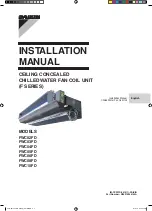
4
Installation, Operation, & Maintenance
YORK
®
STACK FAN
SHORT TERM STORAGE
If fan installation is delayed, store the unit in a protected area. Protect the fan and motor bearings from moisture
and vibration (or shock loading).
LONG TERM STORAGE
If a fan is to be stored for any length of time and the bearings are re-greasable, the motor bearings
should immediately be filled with grease while rotating the fan and then the bearings should be re-
greased and rotated monthly. This will prevent moisture, which condenses within the bearing, from
corroding the raceways.
STORAGE PROCEDURES
Fans should be stored indoors whenever possible where control over temperature, humidity, shock and
dust is reasonably maintained. If units are to be stored outside, they should be covered with a water-
resistant material. Stored equipment should be on a clean, dry floor or blocked up off the ground to
prevent unit from sitting directly on the ground.
PERIODIC CHECK
On a monthly interval, the equipment should be checked to ensure that it has remained in an accept-
able stored condition. The fan and motor should be rotated several times by hand. The fan impeller
should be repositioned approximately 180 degrees from the previous month to prevent damaging the
motor bearings.
BASES (Foundation and Isolation)
Critical to every fan installation is a strong, level foundation. Structural bases must be sturdy enough
to prevent flexing and vibration. YORK
®
recommends using a spring isolated inertia base for all YORK
®
StackFan applications. Design, fabrication, and installation of the isolation base are the customers
responsibility.
After the fan, isolation base, and isolators are installed, the entire assembly must be leveled. Floor
mounted fans should be installed on a flat, level, rigid foundation.
Fans mounted to or within a structure should be placed as close as possible to a rigid member such as
a wall or column. The structure must be designed for rotating equipment; static design for strength
is not sufficient to ensure proper operation. Structural resonance should be at least 20% above the
maximum fan operating speed.
Any ducting should have independent support; do not use the fan to support ducting. Isolating the fan
from ductwork with flex connections eliminates transmission of vibration.

































